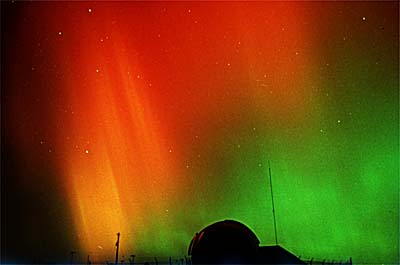
It was a perfect Friday evening.
A day past new moon with clear skies and temperatures falling into the
lower 40's. I had expected company at the ASKC's Powell Observatory on
such a perfect observing night but arrived to a locked gate and closed
dome.
After opening up the facility
and powering up the 29 inch scope (since replaced with a 30 inch) I set
about my task for the evening. Saturn was well placed near the southern
sky meridian and at its best for photography. The sky slowing was changing
from deep blue to black as I popped off some exposures. As I waited for
the seeing to settle down I heard the soft crunching of someone walking
on the rocks outside the observatory. Peering out the dome slit I spotted
a tall, shadowy figure in the fading twilight. After a cautious hello I
learned that he was not a member, but someone that had just dropped in
to see the facility. Needing to take a break, I descended the ladder and
went outside to check out the visitor.
Up from Ft. Scott, Kansas, I
learned that this "new guy" was an amateur astronomer and had heard about
the observatory from a friend. His name was Rick Singmaster and we instantly
struck up a conversation about all sorts of subjects. Rick would soon join
the ASKC and go on to start the highly successful StarMaster Portable
Telescopes company.
As we talked my gaze turned
towards the north and the Kansas City skyglow. The normally white dome
of light had a strange greenish cast and after watching it for a moment
we both thought we could see movement! As twilight faded small, faint patches
of pink started to appear above the green cast and we both knew that we
were witnessing aurora. The Northern Lights had ventured south to Kansas
City!
I dashed into the observatory
and placed a long distance call to fellow observer Charles Douglas and
alerted him to the news. He said he would call as many people as possible
and then take a look himself.
By 8 p.m. people had begun to
arrive and the aurora had really started to put on a show. Reds, greens,
oranges, yellows covered the northern sky. Patches of color would appear,
change shape and disappear. Red spikes were, at times, well above Polaris.
At times activity appeared directly east and even extended as far south
as Orion in the southeast. An intense arc of white started in the east
and within seconds had spread overhead and down to the horizon in the west.
The storm then seemed to decrease in intensity and by 9:30 p.m. there was
barely a trace of any activity. We all headed into the observatory warmup/classroom
and treated ourselves to a warm cup of coffee.
As Nick Reuss later commented,
"We should have noticed the red glow streaming in under the door it was
so bright!". I had wandered over to the door every 10 minutes or
so just to check for further activity with no luck. This time I think my
scream made everyone in the room jump as I opened the door. A 60 degree
long tower of red and orange rose from the northwest horizon and lit up
the sky. I recovered my coffee mug a week later when I found it in the
bushes… laying exactly where I had thrown it while rushing for my cameras.
Two hours of the most amazing displays of aurora ever seen in the Kansas
City area followed. News reports and research showed that the aurora had
not been easily seen in this area since a storm back in the 1950's. Time
signals from Boulder on WWV were almost impossible to hear due to the interference
from the aurora. For a time the green region near the horizon was alive
with shimmering curtains that moved and changed shape second to second.
Unfortunately, this storm also faded shortly after midnight. We watched
the skies until nearly dawn for another storm but nothing but faint glimmers
appeared. Mother nature had put on a great show that rocked a calm Friday
evening. We are still waiting for a curtain call here in the Midwest.-
Vic Winter